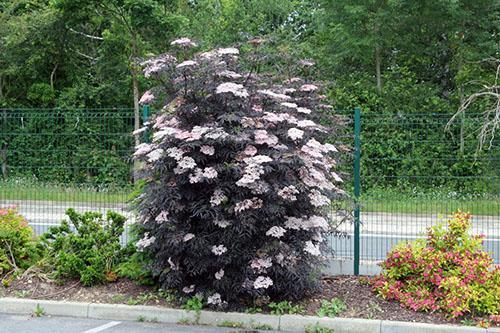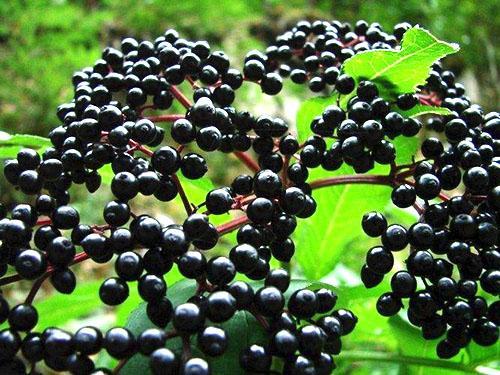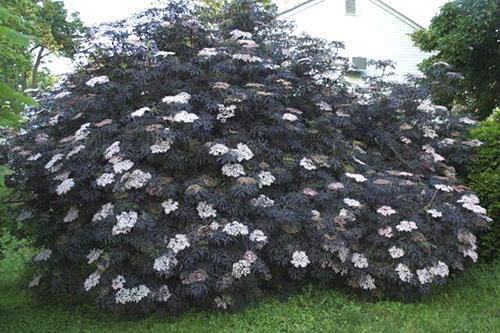Planting black elderberry in the area with seeds or cuttings
 There are about 20 varieties of elderberry, differing in size, shape and structure of leaves, fruits. Planting black elderberry is often carried out for decorative purposes. This culture can be found in the natural nature of temperate latitudes. A well-groomed shrub pleases the eye with numerous branches, large dense foliage, it blooms beautifully and magnificently. It is useful to plant an elderberry bush in the garden or in the country, the smell emanating from it scares away rodents and insect pests... Large bunches of black elderberry look bright and unusual in landscape design. Ripe berries have been used in folk medicine for a long time, they are used to prepare jams, syrups, juices, make wine, eat fresh, and dry them.
There are about 20 varieties of elderberry, differing in size, shape and structure of leaves, fruits. Planting black elderberry is often carried out for decorative purposes. This culture can be found in the natural nature of temperate latitudes. A well-groomed shrub pleases the eye with numerous branches, large dense foliage, it blooms beautifully and magnificently. It is useful to plant an elderberry bush in the garden or in the country, the smell emanating from it scares away rodents and insect pests... Large bunches of black elderberry look bright and unusual in landscape design. Ripe berries have been used in folk medicine for a long time, they are used to prepare jams, syrups, juices, make wine, eat fresh, and dry them.
Description of culture

Elderberry is widely known for its useful and medicinal properties; in folk medicine, all parts of the plant are used - roots, leaves, flowers, berries.
A whole complex of biologically active elements is present in various parts of the plant. Among them are tannins and resinous substances, essential oils, organic acids, vitamins, sugars, carotene. For the food industry, natural dyes are of particular value - anthocyanins, which are part of the elderberry fruit.
Seat selection
 Elderberry is unpretentious, drought-resistant, but loves moisture and light. The shrub grows equally well on personal plots, dachas, within the city. In darkened areas, the plant loses its visual appeal - the branches rush to growth, become thinner, the foliage falls off and thins. The elderberry bush easily coexists with fruit, ornamental, flowering plants, if they do not cast a shadow on it. The soil for the shrub should be selected with a slightly acidic environment. To reduce acidity, lime, dolomite flour can be added to the soil. This should be done before planting the plant in the ground.
Elderberry is unpretentious, drought-resistant, but loves moisture and light. The shrub grows equally well on personal plots, dachas, within the city. In darkened areas, the plant loses its visual appeal - the branches rush to growth, become thinner, the foliage falls off and thins. The elderberry bush easily coexists with fruit, ornamental, flowering plants, if they do not cast a shadow on it. The soil for the shrub should be selected with a slightly acidic environment. To reduce acidity, lime, dolomite flour can be added to the soil. This should be done before planting the plant in the ground.
Planting black elderberry
 The elderberry is planted in black spring. The prepared plant can be planted in open ground in the fall after the leaves begin to fall. It is better to start disembarking in warm weather. In the early days, daily watering and frequent loosening are recommended.
The elderberry is planted in black spring. The prepared plant can be planted in open ground in the fall after the leaves begin to fall. It is better to start disembarking in warm weather. In the early days, daily watering and frequent loosening are recommended.
The flowering of a young elder bush usually begins in the second or third year of life.
Correct fit of the black elderberry:
- a month before planting, the selected place should be cleared of weeds, potash-phosphorus fertilizers, humus or compost;
- two or three year old seedlings are the best choice to achieve rapid plant rooting;
- a hole for a seedling is dug half a meter deep, the bottom is loosened, about half a bucket of water is added;
- the prepared seedling is sprinkled with fertilized soil and lightly tamped, pressing on the soil with your hands;
- it is deepened so that the basal neck remains above the surface of the earth in a free form;
- watering a new plant is best done after a few hours, when the soil settles a little;
- if the seedling is short, then it is left free, if it is tall, then it must be tied to a peg.
Elderberry care rules
 Planting and caring for a black elderberry is not very difficult, the main thing is that the plant has enough light and moisture, it is not clogged with weeds. The bushes grow quickly, without outside help. If this is undesirable, then even during planting, you should limit the hole with iron, slate or construction mesh.
Planting and caring for a black elderberry is not very difficult, the main thing is that the plant has enough light and moisture, it is not clogged with weeds. The bushes grow quickly, without outside help. If this is undesirable, then even during planting, you should limit the hole with iron, slate or construction mesh.
The urea solution is used as a nitrogen fertilizer for planting black elderberries, as well as a fungicide to protect plants from pests, destroy unwanted insects, fungi, mold in the upper layers of the soil, in the root system.
Rules and features of caring for black elderberry:
- in spring, to prevent burns, the main trunk and skeletal branches are painted with lime;
- if after winter some branches turned out to be broken or dry, then they are cut off, the cut points must be treated with garden pitch;
- twice a year (best in spring and autumn) dry fertilizers are scattered around the trunk, watering is carried out with liquid formulations for plant nutrition and development;
- growth enhancers and mineral fertilizing are needed for weakened, slow-growing shrubs;
- when warm weather sets in (in mid-May - early June), the shrub should be disinfected from pests;
- it is recommended to carry out molding pruning of bushes before the color appears - in June or July;
- watering the bushes is carried out as needed, while you need to ensure that the water does not stagnate in the root part;
- it is recommended to retain moisture mulch the soil under bushes, using wood shavings, sawdust, peat;
- it is useful to periodically loosen the soil, remove weeds, apply organic fertilizing - compost, urea, manure, chicken droppings;
- at the end of flowering, repeated treatment with fungicides against harmful insects, powdery mildew, and ticks is carried out.
Elderberry responds well to pruning. In early spring or late autumn, you can cut the shoots almost to the ground, then the growth process is activated, the plant will quickly and fully recover.
Elderberry vegetative propagation
 Reproduction of elderberry by black cuttings is carried out. The vegetative method is considered the fastest and most reliable, preserving the varietal characteristics of the culture. To do this, you can use aboveground shoots, rhizomes, plant parts.
Reproduction of elderberry by black cuttings is carried out. The vegetative method is considered the fastest and most reliable, preserving the varietal characteristics of the culture. To do this, you can use aboveground shoots, rhizomes, plant parts.
How to propagate black elderberry:
- in June or July, before flowering, several shoots should be cut off with a sharp knife, the length of which is 10-12 cm;
- the best breeding material is green shoots of the first year of life;
- 1-2 leaves should be left on prepared cuttings, the rest should be cut off;
- the cuttings are stored until planting in a wet mixture of sand and peat in a 1: 1 ratio.
To speed up the rooting of cuttings after planting, they can be covered with foil. An atmosphere of high humidity is created under the film, which has a positive effect on the process of root formation. For the flow of fresh air, holes must be made in the film. The film is usually removed after a week. At first, abundant and frequent watering is recommended. After one and a half to two months, the plant becomes completely independent.
A high percentage of survival rate (within 95-98%) is shown by stem layers of black elderberry.
How to grow black elderberry in the country:
- for propagation by layering, young non-lignified shoots are used, the age of which is 2 or 3 years;
- the middle part of the shoot is buried in a groove, from above it is mulched with sawdust or old manure;
- only the upper part of the shoot remains free, about 20-30 cm;
- if you make an abduction of elderberry in early summer, then by autumn the shoot will give roots;
- for the winter, the plant is best left in the form of an uncut layering;
- next summer, the rooted shoot can be dug up and transplanted to another place.
The division of the shrub into parts for the purpose of reproduction is recommended to be carried out in the autumn. For this, an adult plant is chosen, mainly a large bush. The separated part of the elderberry can be immediately planted in a permanent place, or temporarily transplanted into a container. The plant is planted in open ground from a container in early spring. You can plant bushes in this way only once a season in order to maintain the health of the mother plant.
Elderberry generative reproduction
 Black elderberry seeds can be used for propagation. In this case, the specific features of the culture can be irretrievably lost. The advantage is that the generative method allows you to get a lot of elderberry seedlings at once, ready for planting.
Black elderberry seeds can be used for propagation. In this case, the specific features of the culture can be irretrievably lost. The advantage is that the generative method allows you to get a lot of elderberry seedlings at once, ready for planting.
Under natural conditions, elderberry seeds are spread by birds and animals, which eat the fruits and release them into the external environment. Passing through the digestive system of a living organism, the seed coat is slightly damaged, which improves their germination in open ground. Scarification of black elderberry seeds is a process of a special violation of the integrity of the seed coat in order to increase their germination.
On an industrial scale, seeds are treated with sulfuric acid for scarification, and they are milled with coarse sand. The seeds prepared in this way are sown in a moistened nutrient medium and await their germination. Plants are abundantly and often watered, mulched, in the winter period of the year they must be covered. Landing in open ground is carried out after about a year.
Correct pruning of bushes
 Elderberry sanitary pruning takes place in the spring and fall. Once every 5 or 6 years, the main branches of the shrub are cut almost to the ground. After that, the plant quickly recovers, new shoots quickly grow in place of the cut branches.
Elderberry sanitary pruning takes place in the spring and fall. Once every 5 or 6 years, the main branches of the shrub are cut almost to the ground. After that, the plant quickly recovers, new shoots quickly grow in place of the cut branches.
How to trim black elderberry correctly:
- In the spring, sanitary pruning is usually carried out to remove broken and dry shoots.
- In the harsh winter, the elderberry can freeze too much, in this case it is recommended to cut the bush at the root.
- Once every 4-5 years, it is recommended to cut the main branches of the elderberry, leaving only a quarter of them.
- Pruning is especially needed for adult fruit-bearing bushes, the plant quickly recovers, renewing itself naturally.
Elderberry diseases and pests
 All varieties of elderberry have one thing in common, they emit special aromatic substances into the environment. This secretion prevents small rodents and insect pests from attacking the plant itself, as well as plantings located near it. The shrub is distinguished by its vitality and endurance, it rarely gets sick. It easily gets along with the very different cultures, it coexists well with conifers and deciduous species. For the prevention of diseases and pests, it is recommended to periodically spray with insecticides. The optimal time for preventive treatment of shrubs is early spring and autumn, after the flowering process is completed. For this, a solution of copper sulfate, karbofos can be used.
All varieties of elderberry have one thing in common, they emit special aromatic substances into the environment. This secretion prevents small rodents and insect pests from attacking the plant itself, as well as plantings located near it. The shrub is distinguished by its vitality and endurance, it rarely gets sick. It easily gets along with the very different cultures, it coexists well with conifers and deciduous species. For the prevention of diseases and pests, it is recommended to periodically spray with insecticides. The optimal time for preventive treatment of shrubs is early spring and autumn, after the flowering process is completed. For this, a solution of copper sulfate, karbofos can be used.
Planting a black elderberry provides decoration of the personal plot, gives a versatile use of fruits and parts of a valuable plant. It is simple to grow and care for the shrub, reproduction takes place in several ways, so you can choose the most suitable one. Elderberry broths and infusions help people cope with many diseases.
Stratification and scarification were confused.
Thank. Fixed.